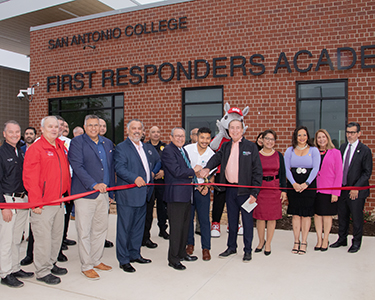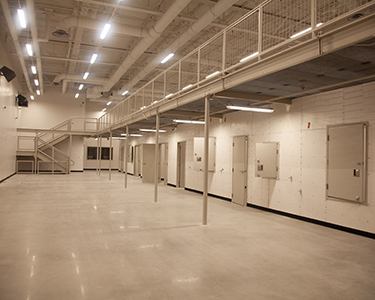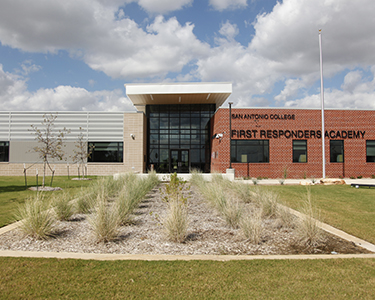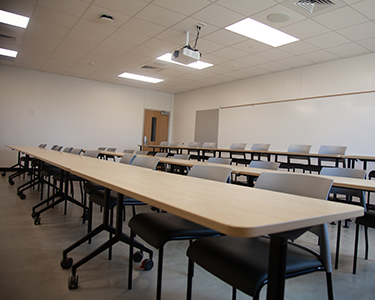SAC's First Responders Academy dedicates new home
December 8, 2023
San Antonio College held a dedication for the new home of the First Responders Academy near Atascosa, Texas. The $20 million, state-of-the-art administration and training facility is the centerpiece for the protective services academic department at SAC.
 The new 32,000-square-foot building is the latest milestone in the evolution of a program that got its start in 1969 by renting classrooms and borrowing equipment from local police and fire departments.
The new 32,000-square-foot building is the latest milestone in the evolution of a program that got its start in 1969 by renting classrooms and borrowing equipment from local police and fire departments.
The First Responders Academy will serve a trio of programs at SAC. The Law Enforcement Academy and the Regional Fire Academy will share space and resources in the new building. The Emergency Management/Homeland Security program will offer several courses there but continue to be based at SAC's main campus.
The new facility is part of an academy complex that has sprung up on 53 acres of land that Alamo Colleges bought in 2008. Back then, the first structure on the property was a concrete block "burn building" used for fire training, followed by a series of modular, portable buildings still used as classrooms and offices.
Over time, SAC added other structures, including a fire station for trucks and equipment and a fabric-covered Sprung building – dubbed "the Onion” – for use as a gym.
The older buildings are tucked into a corner at the rear of the academy property, which is just south of Von Ormy. In contrast, the new facility at the front of the property is highly visible and adjacent to the southbound access road along Interstate 35. Its glass and steel entryway and red brick facade mimic the exterior of most of the buildings on SAC's main campus.
Bexar County voters approved the project in 2017 as a part of a $450 million capital improvement bond for Alamo Colleges.
"In my opinion, this new building takes us to that next level of professionalism," said Frank Poyner, chief of SAC's Regional Fire Academy. "I've got three brand-new classrooms for my academy and better space for all of my employees, administrators, and staff."
 The brightest gem in the new building's lengthy list of amenities is its high-tech "tactical room." Designed for use by police and fire trainees, the two-story, 8,250-square-foot space features a dozen modular rooms that can be furnished to simulate everything from hotel rooms to classrooms. Overhead, a steel catwalk provides a viewing platform for instructors and other observers. The metal stairs leading to the catwalk can also be used by trainees for practice in ascending or descending stairwells alone or in teams during a range of adverse conditions.
The brightest gem in the new building's lengthy list of amenities is its high-tech "tactical room." Designed for use by police and fire trainees, the two-story, 8,250-square-foot space features a dozen modular rooms that can be furnished to simulate everything from hotel rooms to classrooms. Overhead, a steel catwalk provides a viewing platform for instructors and other observers. The metal stairs leading to the catwalk can also be used by trainees for practice in ascending or descending stairwells alone or in teams during a range of adverse conditions.
A powerful loudspeaker system provides a way for instructors to give directions to participants or crank up noise volume levels to heighten the tension in mock search-and-rescue situations. Lights can be cranked up to maximum brightness, down to total darkness, or triggered to flash like strobe lights.
Cameras strategically mounted in every modular room can record the exercises and send video feeds to the central command post's control room.
"When the training is over, we can bring the entire team out and be able to do a playback on the video to actually show them what they did right, what they did wrong, and where they can improve," said Rolando Barrientez, the director of SAC's Law Enforcement Academy.
Until now, the academy used some of its modular classrooms for situation training but lacked the space and resources to make them as realistic and effective as possible.
"Our tactical room changes the training," Barrientez said. "It magnifies our capabilities to be able to offer a student even more real-life experiences.
"The nearest academy that actually has a tactical room similar to ours is at Austin Community College. We are looking not only to train our officer candidates, but to be able to do educational development for local law enforcement agencies as well."
 Everything else at the new facility is equally impressive.
Everything else at the new facility is equally impressive.
The front doors at the main entrance open into a cavernous, two-story atrium. It's furnished with tables, chairs, and a long countertop in front of a bank of microwaves and refrigerators for comfortable dinner breaks and other get-togethers.
A receptionist's desk sits off to the side, just outside a door leading to the offices for academy directors, instructors, and other rooms with tables, chairs, and computer workstations for adjunct personnel.
Wide corridors throughout the building lead to a series of classrooms, each one outfitted with TVs, projection screens, and cameras to record meetings and training seminars. The largest classroom can seat up to 80 people, more than double the capacity of any of the modular buildings.
Deep in the heart of the new building, an armory room with steel doors, wire mesh barriers, and reinforced walls provides safe storage and distribution of the handguns and shotguns used in the law enforcement training program. It's another big step up from the academy's old armory. Fashioned from a used shipping container reinforced with sheets of steel, it was secure – but not climate-controlled.
 Aside from all of the major improvements the new building brings, it might just be the little things that are most appreciated by the staff and students. Like new bathrooms and larger locker rooms, for instance.
Aside from all of the major improvements the new building brings, it might just be the little things that are most appreciated by the staff and students. Like new bathrooms and larger locker rooms, for instance.
Academy staff and faculty have their own bathrooms in the new facility and the locker rooms for trainees have more showers so they can clean up more quickly after physical training and other drills.
In addition to the new building, the academy's capital improvement projects included the construction of an outdoor, concrete driving "pad." The academy used to rent parking lots so its police cadets could learn defensive driving while speeding, weaving, and braking on courses laid out with traffic cones. Poyner, the fire academy chief, said the new 240,000-square-foot pad has enough space for his program to launch a driver-operator certification program and open it up to local fire departments.
"What we're trying to build here and move towards is we truly want to be the tip of the spear for training for firefighters and law enforcement," Poyner said. "We want that reputation of being, 'Oh, you want to be a firefighter? You want to be a law enforcement officer? You need to go to SAC, because they've got a great facility and a great program.'"
-SAC-
To see a collection of photos from the dedication ceremony, as well as a short video from the First Responders Academy, please visit this link to a Dropbox folder.
